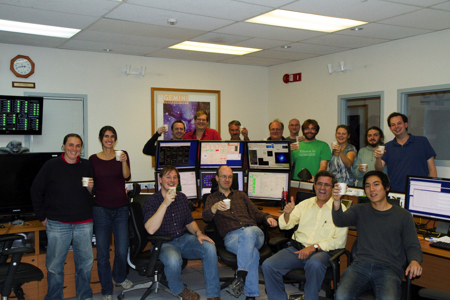Peering at Planets

GPI Technology: Gemini Planet Imager Adaptive Optics uses Boston Micromachines MEMS deformable mirror
February 8, 2014
The orbit of the exoplanet Beta Pictoris b – The first peer-reviewed article with GPI
April 4, 2014Astronomers and engineers recently completed building the Gemini Planet Imager (GPI) to study distant solar systems. GPI will obtain high-resolution images of extrasolar planets by blocking the light of stars and detecting the faint thermal glow of orbiting planets.

Near-infrared image of Beta Pictoris b, an extrasolar planet approximately 60 light years away. The light of the host star, Beta Pictoris, is blocked in this image to reveal the much fainter light of the planet. Image processing by Christian Marois, NRC Canada.
Since the first extrasolar planet was discovered in 1995, thousands of candidate extrasolar planetary systems have been discovered. GPI will enable astronomers to study the properties of these new worlds, including their sizes, temperatures, and surface gravities.
GPI will image planetary systems in the near-infrared part of the electromagnetic spectrum, where the thermal glow of planets – left over from the energy of their formation – can still be detected. This process is far from easy, however; stars outshine planets by a factor of 10 million. GPI will use technology that precisely blocks starlight to reveal faint planetary companions. In addition to the complexities of observing dim planets next to bright stars, the instrument is also designed to make use of adaptive optics – corrections for the turbulence inherent in the Earth’s atmosphere – in order to better resolve planets close to stars. GPI will be able to image planets and stars that appear to be separated by as little as 0.2 arcseconds on the sky – an angular size equal to the width of a quarter seen from 15 miles away.
The primary components of GPI are its coronagraph, which blocks the starlight, and its integral field spectrograph, the camera that records data at 40,000 spatial locations separately. The large light collecting area of the Gemini South Telescope (over 50 square meters) will enable GPI to observe planetary systems up to 240 light years away.
In August of 2013, GPI traveled from Los Angeles on a Boeing 767-300 jet to Santiago, Chile, where a team of engineers and astronomers accompanied the instrument on its drive to the Gemini South observing site at an elevation of 2,700 meters. “GPI’s arrival at Gemini South has been full of excitement for all of the extremely talented and tireless individuals involved in the project,” said Jeffrey Chilcote, a graduate student at the University of California, Los Angeles who works on the instrument’s integral field spectrograph. Chilcote has been traveling monthly to Chile to help install and test GPI.
GPI had its “first light” on November 11, 2013 and initial science results were released at the January 2014 meeting of the American Astronomical Society, held in Washington, DC. The first science results included observations of Beta Pictoris, a star known to host a planet several times more massive than Jupiter. The planet – Beta Pictoris b – appears clearly in the near-infrared image obtained by GPI, confirming the capabilities of the instrument. “We hope that data from GPI will provide a statistical understanding of the processes that form these Jupiter-like extrasolar planets,” says Chilcote. Continued testing of GPI is in progress and the instrument is scheduled to become available to astronomers this year.

The GPI commissioning team assembles at the Gemini South control room for the first night of instrument commissioning on November 11, 2013. Image courtesy of Jeffrey Chilcote.
The GPI collaboration involves an international team of over 100 scientists and engineers. The project is led by Bruce Macintosh of Lawrence Livermore National Laboratory. “GPI and its competitors should revolutionize our understanding of other solar systems,” says Macintosh.
by Katherine Kornei



